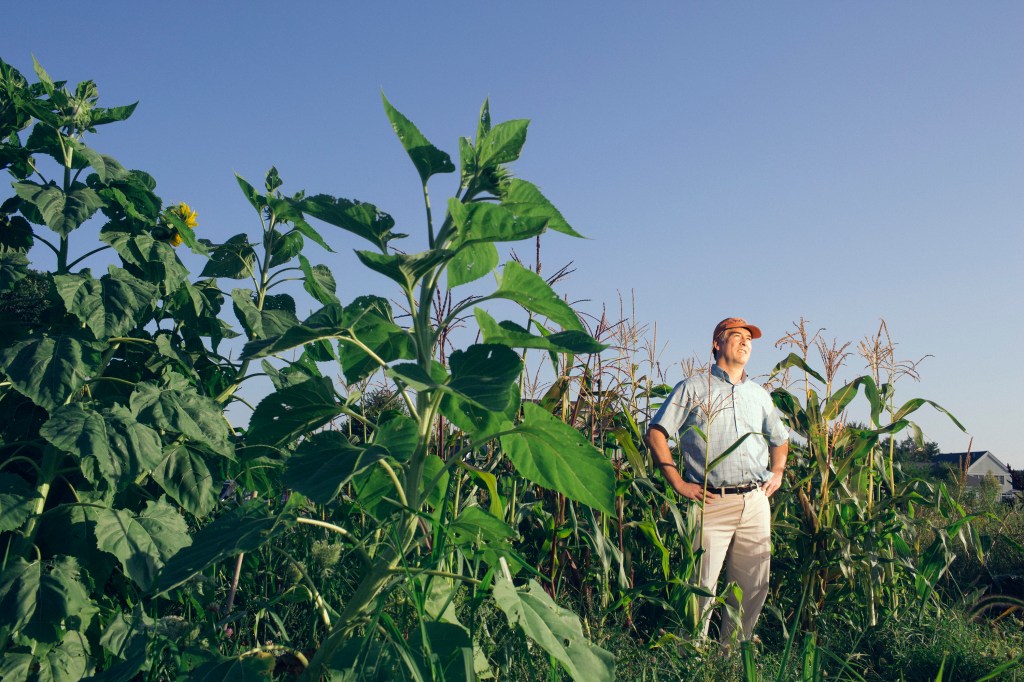Corn is a true American vegetable, first seen by Europeans when they arrived in North America in the 1600s. European settlers have been growing it ever since – but not the same corn that Squanto of the Wampanoag council of tribes taught the Pilgrims to use.
Falmouth resident Andrew Hudson wants to bring back the original heritage corn and its growing methods, inspired in part by history lessons from third grade, by a story he heard on National Public Radio and by the movement to grow more grain in Maine.
Hudson, an occasional gardener who works as a project manager for TD Bank, is conducting a test to see if it can be done.
He lives in a subdivision that abuts the Tidewater Farm and has watched farmers struggle with the hard-packed clay on the site.
Then he heard a story on public radio about a chef in the Hudson River Valley who makes polenta with New England Eight Row Flint corn, which American farmers had stopped using because of its low yield. Some of it was sent to Italy, where it was grown as Otto File corn.
“This is a hardy corn, and it works well for our short growing season,” Hudson said.
Eight Row Flint is not the kind of sweet corn you buy at a farm stand, steam, slather with butter and eat off the cob. It’s a grain corn that would be ground and used to create polenta, tortillas or cornmeal muffins. Eight Row Flint has a rich, creamy flavor, Hudson said.
Once he had his crop seed, he needed a way to deal with the clay at the site the conservation trust permitted him to use. His corn plot is about 20 feet square.
He then remembered lessons on the Pilgrims being taught to plant corn with fish. He believes the fish used were alewives.
“Alewives come up the rivers the same time that people plant corn, and there were bushels of them,” he said.
Hudson’s sister, Landis Hudson, is executive director of Maine Rivers, a group dedicated in part to removing dams to allow the free flow of fish, and she connected him with Jeff Pierce of Dresden, who works with the Alewife Harvesters of Maine.
Pierce sent Hudson some alewives, and Hudson planted the corn with a half a fish per three corn seeds. He later thinned to the strongest single corn plant in each grouping.
Things did not go perfectly.
Something – he believes it was crows – took the fish from half the plot. On the advice of Richard Brzozowski, a University of Maine Extension educator whose office is next to Tidewater Farm, Hudson purchased organic granular fertilizer to use on the corn from which the fish had vanished.
When I visited Hudson’s plot in mid-August, the flint corn was growing well. The fish-fertilized stalks were about 8 feet high with long ears, and the stalks without fish were about 6 feet tall with shorter ears. Sweet corn in a nearby plot, with no fish, was only a couple of feet tall with ears about 5 inches long, but neither of us knows how large that variety would be normally.
Hudson is using several techniques the Pilgrims used, but not all of them.
Cate O’Neill, manager of the interpreters at the English Village at Plimoth Plantation in Plymouth, Massachusetts, said the Pilgrims grew flint corn planted with fish, as they were taught by Squanto.
O’Neill said the Pilgrims had fertilized their fields in England by having cattle graze them and drop manure after the crops were harvested. Since the Wampanoag did not keep herds of animals, they used fish, she said.
One major difference between how Hudson and the people at the living history village grow corn is that Hudson has his in rows, as done at contemporary commercial farms but on a smaller scale. Plimoth uses the traditional Native American three sisters method, with pole beans climbing the corn stalks and squash at the base, to shade the soil and hold in moisture. Many organic farmers and permaculturists now use that method. Although intrigued by the three sisters, Hudson wanted to keep things simple his first year.
O’Neill believes the reason the fish works on the corn is that while the fish decomposes, it serves as compost.
I agree. The standard treatment for clay soil is to add a lot of organic matter. By a lot, I mean 6-8 inches deep over the entire plot. That matter can be anything that has once grown: manure, leaves, grass clippings, kitchen waste – or fish. The organic matter should be worked in with a spade or spading fork, not a rototiller, which would damage soil structure.
One fish per plant will improve the soil around the corn a little for one year, but the benefits won’t last. Some organic matter should be added each year.
Hudson recognizes the need for compost. He has a compost pile near his corn patch where he has put, among other organic matter, used hops from Bunker Brewing in Portland and coffee grounds from his local Starbucks. He plans to improve the soil with the compost for next year’s plot of Eight Row Flint corn, which he hopes to make four times larger than this year’s plot.
He knows it will take a while, but he sees a future where Mainers are eating tortillas made with local corn such as he is growing and oatmeal made with oats grown in Aroostook County. That sounds like a good diet to me.
Hudson says he’ll call me when he makes tortillas from his corn. I’ll give you an update then.
Send questions/comments to the editors.



Comments are no longer available on this story